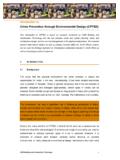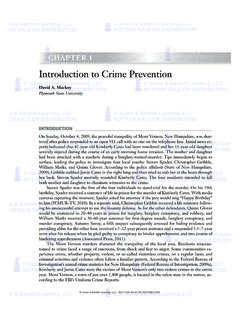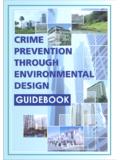Transcription of Crime prevention and the assessment of …
1 Crime prevention and the assessment of development applications Guidelines under section 79C of the Environmental Planning and assessment Act 1979. Crown copyright 2001. NSW Department of Urban Affairs and Planning Printed April 2001. 2001/58. ISBN 0 7347 0184 5. Disclaimer While every reasonable effort has been made to ensure that this document is correct at the time of printing, the State of New South Wales, its agents and employees, disclaim any and all liability to any person in respect of anything or the consequences of anything done or omitted to be done in reliance upon the whole or any part of this document. Purpose of these guidelines These guidelines will help councils identify Crime risk and minimise opportunities for Crime through the appropriate assessment of development proposals. Introduction Criminologists agree that effective design can be used to reduce Crime opportunities.
2 A typical offender will assess a potential Crime victim or a location before committing a Crime . If the design and use of a building or place create the perception that the costs of committing the Crime are greater than its benefits, the potential offender is likely to think twice about committing Crime . Crime prevention through environmental design (CPTED) seeks to influence the design of buildings and places by: increasing the perception of risk to criminals by increasing the possibility of detection, challenge and capture increasing the effort required to commit Crime by increasing the time, energy or resources which need to be expended reducing the potential rewards of Crime by minimising, removing or concealing Crime benefits'. removing conditions that create confusion about required norms of behaviour.
3 What the government is doing to design out Crime The State Government has prepared these guidelines as part of a broad approach to reducing Crime through better design. The Government's strategy includes: guidelines under section 79C of the Environmental Planning and assessment Act 1979 to help councils consider and implement CPTED principles when assessing development applications a training program called Safer by Design run by the NSW Police Service that will enable councils to understand and apply the principles contained in the section 79C Guidelines working with the Australian Building Codes Board to include Crime prevention strategies in the future Building Code of Australia continuing to encourage Crime prevention strategies as good design principles, for example through the publication Better Urban Living, the NSW Model Code and any future design based planning controls.
4 1. The guidelines Why Crime risk needs to be considered Before a decision can be made on a development application, a consent authority (usually a council) must consider the application under section 79C. of the Environmental Planning and assessment Act 1979. Included in section 79C are subsections requiring the consent authority to consider: the likely impacts of that development , including the environmental impacts on the natural and built environments, and social and economic impacts on the locality the public interest. Crime prevention falls under these subsections of 79C. Councils have an obligation to ensure that a development provides safety and security to users and the community. If a development presents a Crime risk, these guidelines can be used to justify: modification of the development to minimise the risk of Crime , or refusal of the development on the grounds that Crime risk cannot be appropriately minimised.
5 How to use these guidelines These guidelines contain two parts. Part A details the need for a Crime risk assessment when considering development applications . Typically, Crime risk assessments are conducted in cooperation with trained local police. Part B outlines basic design principles, which minimise Crime risk. They can be used by councils to justify the modification of development proposals to minimise Crime risk. Councils and local police should: identify the types of development which will require a Crime risk assessment , and prepare a consultation protocol. Consultation protocols are location based. They need specific agreements, which outline the types of development that will be jointly assessed, how consultation will occur and timeframes for consultation. Subject to council discretion, development types not listed in consultation protocols will not require a formal Crime risk assessment .
6 A formal Crime risk assessment is needed for any development that is likely (in the council's opinion) to create a risk of Crime . Examples would include: a new/refurbished shopping centre or transport interchange a large scale residential development (more than 20 new dwellings), or the development or re- development of a mall or other public place, including the installation of new street furniture. Councils are required to consider the principles in Part B of these guidelines when assessing all developments. 2. Part A. Crime risk assessment What is a Crime risk assessment ? A Crime risk assessment is a systematic evaluation of the potential for Crime in an area. It provides an indication of both the likely magnitude of Crime and likely Crime type. The consideration of these dimensions ( Crime amount and type) will determine the choice and appropriate mix of CPTED strategies.
7 How to assess Crime risk There are two important steps when assessing Crime risk: obtain an understanding of the Crime risk of the area, and if required apply (CPTED) treatments that correspond with levels of risk present in the area. These guidelines outline how councils are to assess Crime risk in local developments. They are not sufficient in themselves, however, to inform councils how to conduct Crime risk assessments. To gain a detailed understanding of how to conduct Crime risk assessments and how to apply CPTED principles, council planners need to attend approved training courses. The NSW Police Service provides approved CPTED. training courses, known as Safer by Design, to planners and other key professional groups. Details can be obtained by contacting the Safer by Design Project Manager on (02) 9339 5687, or to e-mail address , or going to the Safer by Design website at Formalising the Crime risk assessment process Local Crime risk assessment processes can be formalised through: a development control plan a council policy on Crime risk assessment a formal agreement (consultation protocol) for targeted consultation with the local police on specific development proposals, or proposals in certain areas of high risk.
8 Where a large proposal is being developed in stages, the Crime risk assessment can be incorporated into site specific development control or master plans. When conducting individual Crime risk assessments, the consequences and likelihood of Crime are identified and measured using recorded Crime statistics, hotspot analyses and Australian Bureau of Statistics (ABS) socio-economic data. The NSW Police Service Safer by Design Evaluation is a Crime risk management instrument based upon Australian Risk Management standard 4360:1999. Use of this instrument and the Companion to the Safer by Design Evaluation will help assessors to identify Crime risk in proposed developments and in existing environments. 3. Part B. Principles for minimising Crime risk Applying the CPTED principles This part of the guidelines outlines basic CPTED principles for use in assessing development applications .
9 Councils need to use these principles so they do not approve developments that create or exacerbate Crime risk. How the principles are applied to each development application will depend on the nature of the development proposal and the prevailing Crime risk in the area. Councils need to be careful when applying CPTED principles as they interact with each other, as well as with other basic principles of good urban design. It is easy to apply one CPTED principle to a development to the detriment of other CPTED or design principles. That is to say, CPTED principles should not be rigidly applied as one might use a checklist, but should be used selectively and flexibly to address Crime risk within the context of responsible urban planning and space design. The CPTED principles There are four principles that need to be used in the assessment of development applications to minimise the opportunity for Crime : surveillance access control territorial reinforcement space management.
10 Surveillance The attractiveness of Crime targets can be reduced by providing opportunities for effective surveillance, both natural and technical. Good surveillance means that people can see what others are doing. People feel safe in public areas when they can easily see and interact with others. Would be offenders are often deterred from committing Crime in areas with high levels of surveillance. From a design perspective, deterrence' can be achieved by: clear sightlines between public and private places effective lighting of public places landscaping that makes places attractive, but does not provide offenders with a place to hide or entrap victims. 4. Access control Physical and symbolic barriers can be used to attract, channel or restrict the movement of people. They minimise opportunities for Crime and increase the effort required to commit Crime .














